________________
Rao Saheb C. S. Shrinivasachari
a thorough examination of all available evidence as to the reliability of that tradition, come to the conclusion that "a dispassionate consideration of the above-mentioned facts leads one to the conclusion that the Jaina tradition has some basis to stand upon." He says that though the evidence may not be quite decisive, it may be accepted "as a working hypothesis until the contrary is proved by future research."
II
Among members of the Jaina persuasion in the ancient Tamil land, the Arhat was considered to be the supreme intelligence which rules the Universe. From the famous epic work, Silappathikaram (Epic of the Anklet) we learn that they had two principal vows, not to speak an nutruth and not to kill any living creature; and the community was divided into two sections, the sra vakas, (bearers) or laymen and the religieux of whom there were five classes, Pancha-parameshtin namely, Arhas, holy men; siddhas, those who had acquired supernatural powers, acharyas, priests; upadhyayas, religious teachers; and sadhus, pious men. The Jainas had pulpits erected near their shrines and at road-crossings from which they preached their tenets. Women were also admitted into holy orders and took vows of celibacy. Monks and nups carried an alms-bowl, a water--pot suspended from a hoop of twine and a bundle of peacock-feathers for softly sweeping off insects from the places where they sat or lay down. They frequently pronounced a short prayer of five letters, which was called the Panch-mantra.
In the time of the early Pandyan ruler, Nedunjeliyan, the practice of the Jaina cult was perhaps allowed only on the outskirts of the Madura city. A regular Jaina Sangha was established in the Madura Country in 470 A. D. by Vajranandi, the pupil of Sri Pujya pada. 4
1 Epigraphia Carnatica: Vol: II Inscriptions at Sravana Belgola-Revised edition. (Bangalore, 1923)-p. 42.
2 The correct interpretation would be final emancipation instead of supernatural powers..--Editor.
3 Silappathikaram; Canto x lines 99-101 ( Commentary of Adiyārkku Nallar) edition of Mr. V. Swaminath Iyer 1892–p. 239.
4 From the Digambara Darsanasara of Devasena writing in Samvat 909J. B. B. R. A. S. Vol. XVII, Part I, p. 74.
Shatabdi Granth ]
.: 111 :
Jain Education International
For Private & Personal Use Only
www.jainelibrary.org




